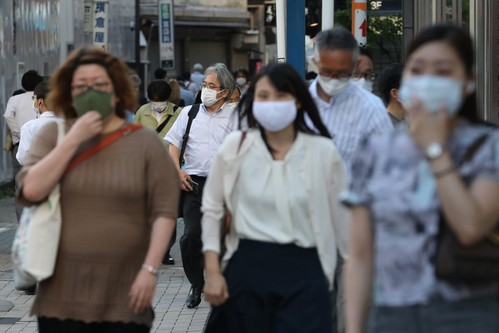IANS Photo

New Delhi, September 17 (IANS) Although the intensity and severity of the pandemic has reduced, Covid-19 has not gone away by any stretch of the imagination. For instance, it is currently making several people ill in the UK, Ireland as well as the US, to name a few countries.
Hospitalisation rates are slowly going up, and people who have recently travelled from India to these countries have verified this. In fact, fearing the arrival of new variant BA.2.86, the UK brought forward the rollout of the updated mRNA vaccine. Canada has recently emphasised the use of masks. Such is the level of urgency shown by these countries.
At this time, India is going through a low tide of Covid. We had a high tide season from March to April 2023, where many cases were reported yet most people were able to be treated at home.
In fact, the test positivity rate shot up from 0 to 42 per cent in only three weeks in areas where surveillance was active, showcasing the extent and speed of spread of Covid within any community. Fortunately, fatality and severe outcomes were relatively few compared to previous waves.
Japan has gone through its ninth wave, the country’s diligent testing continues to show the world the true picture of Covid. Unfortunately, testing has dropped to extremely low levels globally and therefore it is not possible to measure the true disease burden anymore.
However, indirect markers of Covid spread such as wastewater surveillance continue to provide useful pointers.
Although there are scattered reports of Covid from India at this time, the numbers are not extraordinary. Many people report fever presumed to be viral in origin. Influenza and dengue are making the rounds, but not Covid.
The reason for concern in the latter half of 2023 is the arrival of an all-new variant called BA.2.86, armed with numerous mutations and markedly different from any version of the SARS Cov2 virus seen until now.
It has already been detected in multiple countries and is slowly increasing in number, as has been the early trend with other major variants in the past.
It is worth noting that as soon as a new variant of significance appears, it does not immediately take over the world. Instead, it circulates in smaller numbers acquiring new mutations that enable its spreading process and then once it reaches a critical mass, the growth curve turns steep.
The world of science is carefully watching BA.2.86 along with certain other variants that have a unique set of mutations called FLip mutations. These include mutations in consecutive positions 455 and 456 on the RBD, known as L455F and F456L mutations.
A recent BA.2.86 outbreak in UK elderly care homes affected 87 per cent people, which is an exceptionally high attack rate. This is especially significant because these individuals had only recently received a booster dose. This indicates the extreme immune evasiveness of the variant, along with remarkable ability to spread in a closed community.
Fortunately there are no reports yet of the disease being more severe than other circulating variants. It is also unclear whether it will be able to outcompete the currently circulating versions of Omicron belonging to the XBB sublineage. BA.2.86 likely evolved over a long period of time in a person who was immuno compromised, and has only recently started circulating in the general population. As it circulates more, it will likely add more mutations that give it a fitness advantage.
At this time, according to INSACOG’s surveillance report, XBB descendants are still prevailing in India. These are recombinant versions of omicron which have been dominating the world over the past year. A recombinant variant is the result of the mixing of genetic material of two separate viruses simultaneously infecting the same person, considered a rare occurrence in the case of Covid.
The virus has shown a continued tendency to evolve by adding mutations that are of benefit, and doing away with those that aren’t, essentially a balancing act of evading the human immune response while improving its ability to get inside cells.
The future trajectory of Covid-19 remains unclear. There is no doubt that it is a cyclical disease causing recurrent waves which have no relation to seasons. But there is concern regarding the ability of this virus to generate vastly different variants which could potentially have different biological characteristics.
It is widely believed that the immunity derived from widespread vaccination as well as from surviving natural infection has played a role in keeping recent waves of Covid relatively less devastating.
Although Covid manifestations are relatively mild among healthy young people, this is unfortunately not the case among vulnerable people - who are part of all populations.
They include the elderly as well as those with significant comorbid conditions such as cancer and chronic kidney disease. We have a collective responsibility to protect these individuals as well during future waves of Covid.
In addition, the problem of long Covid has vexed experts. This is a set of multiple persistent medical issues that follow about one in 20 infections. Symptoms include tiredness, shortness of breath, musculoskeletal pain, palpitations and memory problems, many of which persist beyond two years.
Long Covid has caused chronic suffering among people of all ages, and contributed to poor quality of life and loss of productivity.
India has not used updated Covid vaccines so far, and there is a difference of opinion about how much incremental benefit such products will provide over and above the protection that is already existing. For instance, in 2022, the acceptance of the updated BA.4/BA.5 bivalent booster had been low in the United States at only 17 per cent.
Therefore, it remains to be seen how many people will take the new monovalent XBB.1.5 specific booster.
India has gone through waves of Omicron infection subsequent to the vaccination series that was based on the original strain of the virus. A study from JSS Medical college Mysore has shown that 36 per cent of those who received a third dose had breakthrough infections, showing the immune evasion of newer variants.
Thus, the population has had assorted immune exposure not only due to vaccination, but also from surviving natural infections - both before and after vaccination. In this setting, the role of further doses of vaccines used in India is unclear at this time, and such decisions will need to be individualised based on risk profile.
Thus, although the WHO has declared the emergency phase of the pandemic to be over, the disease still lurks in various parts of the world following a cyclical pattern. The health impact of the pandemic extends beyond the immediate outcomes such as hospitalisation and deaths to long-term problems like long Covid, and therefore it is prudent to avoid repeated bouts of infection.
Non-pharma measures such as masking, improving room ventilation and avoiding mass indoor gatherings during times of a surge will go a long way in keeping our community safe.






